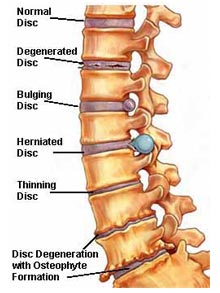
Degenerative Disc Disease most often occurs in the discs in the lower back (lumbar region) and the neck (cervical region). As we age, spinal discs may break down, or degenerate, causing Degenerative Disc Disease. This can result from a loss of fluid in your discs which makes them thinner, narrowing the space between the vertebrae. Although aging can contribute to the degenerative process, there is usually an older injury involved also.
This could be a single traumatic event or a stressful, repetitive motion. This is evident as Degenerative Disc Disease is usually present in one or a few levels of the spine and not the whole spine. Correction of the issue in the spine can, and frequently does, slow or stop the degenerative process. While the condition can not be reversed, slowing or stopping the process can add years to the functionality of the spine and the nerves that exit the spine at the affected levels.
Small cracks in the outer shell of the disc can also cause the disc to bulge which may start the degeneration process. These changes are more likely to occur in cigarette smokers and people who engage in heavy physical work (such as heavy lifting). Those who lead sedentary lifestyles and are overweight are also more likely to suffer from degenerative disc disease.
